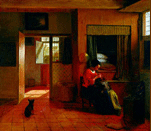










10.
Women and Religious Politics
Organizers:
Description:
We will begin with introductions of all present.
After introductions, we will each speak for two minutes to introduce our topics to help people choose a discussion group. Professor Jaster will discuss ecclesiastical attire for women, examining the conflicting advice to dress humbly and to dress according to position, and introducing questions of the differences between rules for religious women and secular women and the changes in rules after the Reformation. Dr. Nelson will argue that the articles and settlements negotiated for the marriages of Anna of Denmark to James VI of Scotland (1589), of Elizabeth Stuart to Frederick, Prince of the Palatinate (1612-13), and of Henriette Marie de Bourbon to Charles Stewart (1624) reflect changes in attitudes towards religiously mixed marriages and reveal a growing investment in “proper” Christian education for the offspring of these marriages. Dr. Osherow will explore the ways in which authors of mothers’ advice books invoked the Hebrew Bible figure of Hannah to model proper Protestant behavior and to shape policies of child-rearing and education in the home. Professor Donawerth will suggest that we view Elizabeth Cary’s The Tragedy of Mariam in light of her reading in protestant and catholic controversy as an example of casuistry, the exploration of a case of conscience–if you are married to the worst man possible, a tyrant who has killed your grandfather and brother and stolen your family’s birthright, what are your obligations? Professor Kothe will discuss Luisa de Carvajal, a Spanish missionary to England in the early seventeenth century, who wrote an autobiography that was published in Spanish and became part of a general trend toward a rhetoric of women’s passion in the mid-seventeenth century.
We will then form small groups for discussion, each facilitator serving as a discussion leader for a group, participants divided according to interest in topics already briefly introduced: debates about women’s ecclesiastical attire; the problems of marriages of mixed religion with regard to Stuart women and marriage negotiations; Hannah and the religious politics of early childhood education; casuistry and Cary’s Mariam; and Luisa de Carvajal and female Catholic missionaries. As well as the particulars of each case, we will concentrate on four questions for later whole-group discussion. How does each case reflect the gendered nature of religious politics and women’s participation in them? How do rules for religious women differ from rules for secular women? What set of boundaries mattered in each case and how did women negotiate them? What does each case tell us about the ways women were represented in religious texts?
We will conclude with a general discussion of those four questions.
Preliminary list of readings:(total 15 to 20 pages maximum)
4 pp. of Ancrene Wisse and other texts on ecclesiastical attire for women.
4 pp. selected from “Articles accordez entre les commissaires du serenissime roy de la Grand Bretagne” (1624) “Description of the London wedding and festivities, also the journey home and the Heidelberg reception [of Elizabeth and Frederick], illustrated with etchings by J.T. de Bry and G. Keller” (1613) Letters of James VI/I, Charles I, Elizabeth Stuart, Henriette Marie de Bourbon
4 pp. illustrating the use of Hannah, selected from
Elizbeth Grymeston, Miscellane Meditions, Memoratives (1604)
Elizabeth Clinton, The Countesse of Lincolnes Nurserie (1622)
Elizabeth Brooke Joceline, The Mothers Legacie to her Unborn Child
(1624)
4 pp. on casuistry and Cary, including
2-3 pp. from William Perkins’ The Whole Treatise of the Cases
of Conscience (1606) and one other casuistical manual
1 p. from Elizabeth Cary, The Tragedy of Mariam
4 pp. from Luisa de Carvajal in Spanish and in English
translation
|
|
|
||||||
|
|
 |
 |
|
||||
 |
|
 |
|
||||
|
|
|
||||||
|
|
|
||||||
 |
|
||||||
|
|
|
||||||
| |
|
||||||
 |
|
||||||
 |
|
||||||
 |
|
||||||
 |
|
||||||
|
|
|
||||||
|
|
 |
|
|
||||
 |
|
||||||
|
|
|
|
|
|
|
|
|